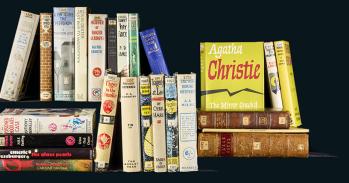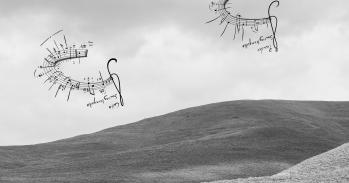
On 6 November Professor Steven Connor will give a talk at the Centre for Research in the Arts, Social Sciences and Humanities on the affinity between tap dance and sound cinema, interspersing his discussion with clips from Hollywood musicals. It’s all to do with sound, movement and counting.
On 6 November Professor Steven Connor will give a talk at the Centre for Research in the Arts, Social Sciences and Humanities on the affinity between tap dance and sound cinema, interspersing his discussion with clips from Hollywood musicals. It’s all to do with sound, movement and counting.
Tap dancing reminds cinema of its origins in the turn-of the-century world of vaudeville, circus and carnival.
Professor Steven Connor
Tap dance is a mesmerising feature of much early sound cinema. Think Ginger Rogers and Fred Astaire, dapper suits and swirling skirts. Tap is a form obsessed not just by style but also by speed with the most talented performers capable of footwork that’s dizzyingly fast. In 1946 American tap queen Ann Miller challenged an expert typist to a public display of percussive rapidity, out-tapping her opponent at 500 taps per minute. But the world record for tap-speed is held by the English star Roy Castle, who in 1973 achieved an awesome 1,400 taps per minute.
The movements of tap dancers are strangely inhuman and almost robotic, the rhythmic taps of their steel and wood clad feet echoing the automated ticking of clocks, the clicking of morse code, the thrum-thrum of sewing machines and the purr of celluloid film spooling through a projector in the glowing darkness. Intriguingly, Castle’s phenomenal fleetness of foot works out as around 24 taps per second, the same as the standard frame-rate of cinema.
In a talk on 6 November at the Centre for Research in the Arts, Social Sciences and Humanities, Steven Connor, newly-appointed Grace 2 Professor of English at Cambridge University, will explore the electrifying connections between tap dance and the form of sound cinema in a discussion titled Two-step, Nerve-tap, Tanglefoot: Tapdance Typologies in Cinema.
Professor Connor’s alliterative title for the talk (part of a series looking at aspects of film) plays with the language of tap - tanglefoot and nerve tap are both tap steps - and reflects his interest in an art form that in treads a delicious and dangerous line between vulgarity and sophistication. And, by virtue of its bodily associations, tap resists being lifted into the condition of high art.
“Tap dancing reminds cinema of its origins in the turn-of the-century world of vaudeville, circus and carnival as popular spectacles. One can see in the very forms of tap dance a kind of struggle between the technical wizardry of cinema in its developed form and its lowlier corporeal origins. It’s the difference between the smooth aerial flights of Fred Astaire and the earthier moves of Bill ‘Bojangles’ Robinson,” he says.
“The tension between the clog-dancing rustic and the sharp-suited man-about-town testifies to a class ambivalence that is never quite resolved in tap-dance, making it all the more provocative.”
To illustrate his points, Professor Connor will show extracts from tap-dancing films. His longest clip will show the song ‘Slap That Bass’ from Follow the Fleet in which Astaire dances in, and with, the machinery in the engine room of a ship.
Others clips will include: the scene from The Little Colonel in which Bill Robinson shows Shirley Temple his signature staircase dance as a way of persuading her up to bed; the scene from Top Hat in which Fred Astaire, having woken Ginger Rogers in the bedroom below with his tap practice, soothes her back to sleep with a sand dance; and the famous routine, also from Top Hat, in which Astaire uses his cane and tap-steps to ‘machine-gun’ a row of rival dancers.
In discussing the intensely repetitive element of tap, Professor Connor will touch on a recent study that reports on the appearance of involuntary tap-dancing as one of the symptoms of epileptic seizure. It looks back on the epidemic of tarantella (a folk dance) said to have swept across Europe in the 16th century and forms of dyskinesia – or uncontrolled but rhythmic movement that characterises types of chorea such as St Vitus’ Dance.
Professor Connor, who joined Cambridge last month, has spent the last 33 years teaching English at Birkbeck College in London. During this time he wrote and published extensively on 18th and 19th century authors such as Charles Dickens, James Joyce and Samuel Becket. He has also tackled topics not so straightforwardly literary in books that venture into areas of metaphor and representation with titles that include The Book of Skin (2004), Fly (2006), and The Matter of Air: Art and Science of the Ethereal (2010).
Awaiting publication in 2013 is his latest book Broken Voices, a study of onomatopoeic vocal noises that devotes an entire chapter to an investigation of rattley, pitter-pattery t-sounds.
Professor Connor says: “In early medieval literature, these sounds had their own devil called Titivullus, whose job it was to collect up every stray titter during prayers or stutter of the priest during the sermon. As a result we have the wonderful word titivillitium which meant empty or trivial noise – it’s a word that might also perfectly describe the percussive effect of tap.”
Popular performance has long been a source of fascination to Professor Connor. His book Dumbstruck: A Cultural History of Ventriloquism (2000) investigates not just the spooky showmanship of the ventriloquist but also other forms of unofficial entertainment and forms of modern media. He traces his interest in the history and language of tap dance back to his time as a graduate student at Oxford.
“I took lessons for a few years and was quite serious about it. I used to find skittering about across a dance floor in a disused fire station a welcome diversion after a day in the library. I’ve been informed that telling the interviewing committee at Birkbeck that I was a tap-dancer when I wasn’t thinking about literature clinched my first appointment there,” he says.
“I haven’t done it for decades now but I must admit that I did try a few lumbering steps while I was watching some of the many Hollywood musicals I have been getting through in the last few weeks.”
Professor Steven Connor will talk about Two-step, Nerve-tap, Tanglefoot: Tapdance Typologies in Cinema at CRASSH (Centre for Research in the Arts, Social Sciences and Humanities) on 6 November, 5-7pm. Open to all, no need to book.
The event is part of a series organised by the Cambridge Screen Media Group.
For more information on Professor Connor’s work www.stevenconnor.com.
This work is licensed under a Creative Commons Licence. If you use this content on your site please link back to this page.





